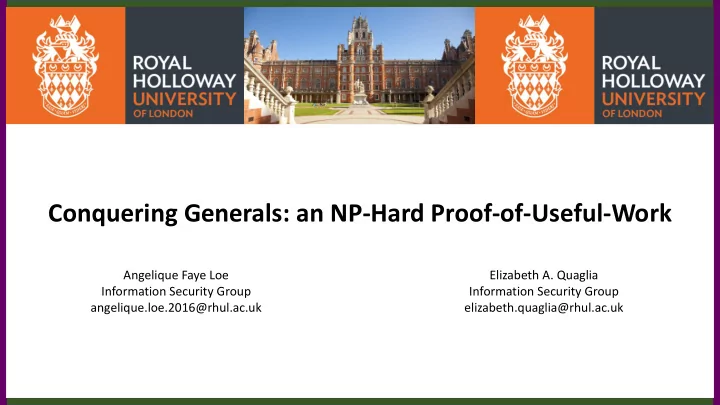

Conquering Generals: an NP-Hard Proof-of-Useful-Work Angelique Faye Loe Elizabeth A. Quaglia Information Security Group Information Security Group angelique.loe.2016@rhul.ac.uk elizabeth.quaglia@rhul.ac.uk
Introduction Information Security Group • Proof-of-Work algorithms are used to establish consensus in distributed untrusted Peer-to-Peer systems, such as cryptocurrencies • The most widely deployed PoW is based on Hashcash, which is used by Bitcoin • The Hashcash scheme has 2 commonly identified issues: 1. The electrical energy consumption of the scheme has attracted criticism 2. The ‘Hardness’ of the scheme does not belong to a known computational complexity class
Goals Information Security Group • Address the energy consumption by devising a two-round Hybrid Proof-of -Useful- Work • Address the heuristic notion of ‘Hardness’ by offering a well known NP-Hard problem for the Proof-of-Useful-Work • We opt to construct an instance of the Travelling Salesman Problem (TSP) • Identify and address another waste issue, by highlighting the capital expenditure into ASIC mining Hardware
Energy Usage and Hashrate Growth Information Security Group Bitcoin Energy Consumption Index
Related Work: PoW Variants Information Security Group
Our Contribution Information Security Group • Differentiate our PoUW as the first to consider a hybrid approach to include ASIC based miners • Calculations show that CapEx on ASIC mining hardware is circa 4.3 Billion USD, - not counting the data centre hardware!
Conquering Generals Information Security Group • Conquering Generals is a Hybrid two round Proof-of-Useful-Work • Overview of the Proof-of-Useful-Work: 1. Runs on a 10 min deterministic mining interval 2. The first round is the Hashcash round 3. The second round is the NP-Hard TSP round
Constituent Algorithms Information Security Group • Three Algorithms make up the PoUW scheme: • Gen & Verify run in polynomial time 1. Gen: generate challenge 2. Solve: solution to challenge 3. Verify: validate solution • Hashcash round: Solve is heuristically believed to run in O ( 2 n ) time • TSP round: Solve algorithm is one (or more) algorithms which may be selected or designed by the miner
Round 1: Hashcash Information Security Group • {1,…,m} miners will perform the PoW • Gen1: Create a challenge based on Candidate Block • Solve1: Perform a double iterated SHA256 hash on the Block Header & concatenate a nonce • Submit lowest hash/ solution after 3 minutes to other miners (this limits the energy usage of the ASIC miners) • Verify1 algorithm: run on each of the {1,…,m -1} solutions • Sort each sound solution and extract the min value • The min value in Round 1 will be used in Round 2
Round 2: Construct a TSP instance Information Security Group • Submit lowest solution after 4 minutes to other • Gen2 will create a challenge as follows: miners 1. Recursively double SHA256 hash the min solution for Round 1, n times. (where n is the • Sort received solutions and extract min2 value number of cities on the TSP instance, and also the difficulty parameter) • Verify2 will validate the permutation of n cities and 2. Extract the 128 LSB’s from each of the n associated sum of min2 hashes to act as x and y coordinates on a 2^64 x 2^64 Euclidean Plane • If min2 a Valid solution, Increment Block Number, Calculate l l 3. 2 norms for each n(n-1)/2 edges on a Mint Currency (for winning miner), Commit complete graph Transactions and Loop to create next Block 4. Construct a graph distance matrix • Solve2 will then run and find a solution consisting of the permutation of cities providing the min tour distance (sum) via all cities, returning to the starting city
Toy Example Information Security Group
The Name ‘Conquering Generals’ Information Security Group • Conquering Generals comes from the merger of two problems 1. The Travelling Salesman Problem 2. The Byzantine Generals Problem • A group of Generals have a conquering mission • Initially, the Hashcash round represents the reconnaissance to determine which cities to conquer • Subsequently, the TSP round represents the optimal order in which they wish to launch their mission ensuring an optimal path is taken • Instead of the innocuous Salesman, we have a group of Conquering Generals
Conclusion Information Security Group • We have presented a concept for a Proof-of-Useful-Work which mitigates the potential loss of 4.3 Billion USD on ASIC hardware • It addresses electrical energy usage by limiting the Hashcash stage to 3 minutes • It also addresses electrical energy usage by introducing a fiscally incentivised platform to engage in algorithm research and design for the NP-Hard TSP. This dovetails into addressing the heuristic ‘Hardness’ issue associated with Hashcash. • We finally recall that: ‘ NP-Complete problems have the intriguing property that if any NP-Complete problem can be solved in polynomial time, then EVERY problem in NP has a polynomial time solution, that is P = NP ’
Recommend
More recommend